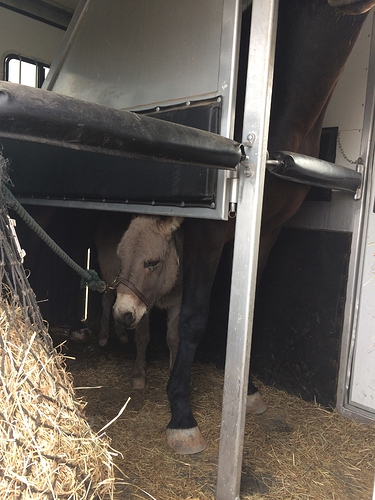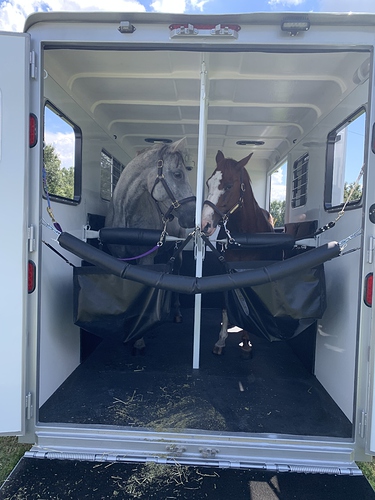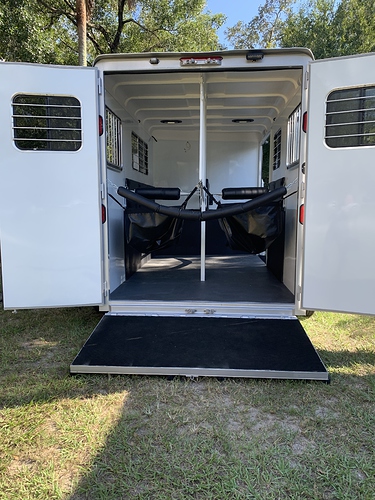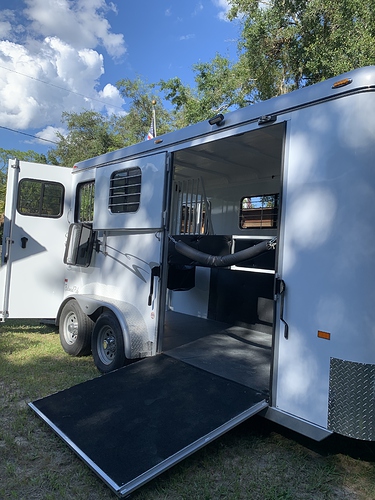Montana’s girl. I already know she travels fine loose and backwards because the trailer I am about to sell (unless the Hawk can’t work) is a slant load that I have turned into an open stock. It has slatted, open sides, too. I bought the Hawk because she’s always travelled well in a straight load in the past. But for the past few years she’s been loose in an open stock, facing backwards by her own choice.
Fivestrideline,
In the past, when she was trying to get out of the slant load, she was fighting the divider, hard, so it could be that she thinks fighting this divider is what will get her out. But I don’t think there’s any way she could have made enough contact with that screw to carve herself up the way she did–or split her skin open as she did once the screw was gone–unless she wasn’t just leaning, but was throwing her entire weight into the divider.
If the Hawk can’t work, I’ll go back to my 2 horse slant and keep it open, and keep my eye out for a quality stock trailer with a gate in the middle. It has to also have a dressing room and an escape door. I haven’t seen a trailer designed like that. Maybe some of you can point me to one?
The first time I ever shipped my mini-donkey with another horse, I stopped to check on them and found this:
I just about had a heart attack but he was leaning all his weight on his halter and lead rope in order to stand underneath his buddy, so I guess that’s where he felt most comfortable. I didn’t ship them often thankfully. After that first time I just left him loose because I figured adding a low-tied rope to that situation wasn’t helpful.
If I were you I would definitely try shipping her on the right side before trading in the trailer. You’d at least have more info. My 28-yo retiree started scrambling and leaning in my 2-horse straight load about 10 years ago, when his upper level dressage career was winding down, and switching him to the right side completely resolved it.
The Hawk has wood plank floors with mats on top. On top of that I put a mix of shavings and soaked bedding pellets. Same bedding as I used in the old slant trailer.
BlockquoteIf I were you I would definitely try shipping her on the right side before trading in the trailer. You’d at least have more info. My 28-yo retiree started scrambling and leaning in my 2-horse straight load about 10 years ago, when his upper level dressage career was winding down, and switching him to the right side completely resolved it.
Great info! But isn’t it unsafe to haul a single half ton horse on the ditch side and leave the driver side stall empty? that’s what I’d always heard. Doesn’t it make the trailer unbalanced? Can you go down the highway like that at 65 mph safely?
You will be fine on a highway. Your trailer isn’t going to flip over spontaneously just because the horse is on the right side, even on a crowned road. The reason to put the horse on the left is in case the right-side tires go off the edge of the pavement, say on a narrow road when there’s oncoming traffic. If that happens where there is a drop-off between pavement and shoulder, yes the horse being on the right could contribute to imbalance. But it’s a risk you will have to weigh yourself in light of how and where you drive. I do know people who haul on the right without issue.
Thank you very much. I will try this.
Libby, another question:
Do you have any thoughts on just why it would help an older dressage horse to be in the ditch side stall instead of the other one?
Weighing in with my usual horse cult member complaint: too often the only so-called horse-related research we have access to has been produced by manufacturers. Ergo, we get lots of marketing, almost never actual research.
As a sometime assistant in my sister’s horse transport business, I’ve combed academic paper sites for horse transport data, i.e. actual studies by actual scientists, behaviorists, and mathematicians. Sharon Cregier of U. of Edinburgh is one of the few names that shows up regularly.
While she has recently published annotated bibliographies of what research there is (some of it market originating) here: ATA_Horse_Transport_Annotated_Bibliograp.doc (148.9 KB), one of her most cogent observations comes from a 2009 “Best Practices” conference on horse transport.
Other than the studies by automotive engineer David J. Holmes and horseman Wentworth Tellington (Cregier 1980), no subsequent study has approached the problems of horse transport design with the imperative that it integrate equine anatomy, behaviour and automotive dynamics.
In May 2024 she notified academia.edu (my usual quick source for available research) that she had published: Adapting Road Transport to Horse Behavior, and posted the abstract on another site, here. In a quick search, I have not seen the whole paper.
From that abstract: Well-designed transport allows the horses to maintain their balance and rest hindquarters during travel. Proper placement helps to keep the transport on the road during mountainous stretches or driving events such as braking. For example, travelling horses facing away from the direction of travel counteracts the tendency to pitch toward the cab on braking.
I’m sad – for the health of your horse-related expense accounts – to say that Cregier would probably recommend any adjustments you can make that allow your mare to return to the rear-facing travel option.
Besides open stock trailers, the only US company I know of that builds 100 percent rear-facing horse trailers is Balanced Ride. I’ve never seen one IRL, however.
Edited to fix Sharon Cregier’s misspelled last name. D’oh!
Hi Sami-Joe
Thanks for the info on the Balanced Ride trailers and the research info. I enjoyed looking at these trailers–looks like they are made by Hawk. I could possibly modify my Hawk, with the help of a fabricator, to allow the horses to ride backwards safely with the existing divider. But, if riding backwards was the goal, why not just put them in an open stock trailer and let them put themselves in whatever position they like? Or even better, an open stock trailer with a slam gate that would create two box stalls? Much cheaper and lighter.
The Balanced Ride trailers are extremely heavy for a two-horse BP and I a NOT buying a new truck (I have a 20 year old 3/4 ton that has had just about everything replaced or upgraded). Plus their dressing room is extremely small, and I have a lot of camping gear.
I am thinking that I should sell my 2017 two horse slant before it falls apart any further, because I don’t feel comfortable using it for long distances, and if my Hawk is not going to work as a two-horse straight load, I will have to remove all the dividers, put in a couple of tie rings in the rear, and use it as an open stock until I can find a stock trailer with a slam gate and a dressing room. Not ideal, but I am hoping this is a claustrophobia issue and not a needing to ride facing backwards issue.
My current plan for figuring this out is as follows:
- Have Maresy assessed by the chiro vet and get his input on her behavior with the Hawk trailer
- Watch her through a camera and see if riding with the Hawk as-is after treatment has allowed her to ride without pressing into the divider. If not, then:
- Pad the floor heavily with a deep layer of soaked peat moss, soaked bedding pellets, and damp shavings to create a mattress effect. This is the bedding I started using after she was diagnosed with ringbone. If that doesn’t work, then:
- Remove the head divider. If not, then:
- Remove the lower stall divider. If that’s the solution, then I have to figure out how to travel with the mini–either put him in the very front under Maresy’s nose, riding sideways, or create a box stall for him in the ditch side stall. If removing the lower stall divider doesn’t help, then:
- Remove the entire center divider, head still facing forward. If she’s not happy with that, then:
7: Remove all the central hardware, turn the trailer into a big box stall, put tie rings over the rear windows, and let them ride in the Hawk the same way they were riding in the old trailer. And start looking for a cheap but well built, used stock trailer with a slam gate. And dressing room (if such a thing exists). And accept that this was a very expensive lesson. Hopefully I’ll then be able to find a buyer for the Hawk.
At least by following this line of experimentation–from least trouble and cost to the most–I may find a sweet spot in between her hurting herself and having to sell the trailer.
Anything I haven’t thought of?
Best investment I’ve EVER made was my 2 horse balanced ride trailer and a camera!!! It solved all my problems which sound eerily familiar to your back story.
I usually just haul the big grey WB. Center divider latched to the side so he can spread his feet if need be.
My pleasure, SHF.
Other than borrowing/renting someone’s big stock trailer, I think you’ve got some good research plans of your own. Maybe you want to contact Professor Cregier (corrected spelling  ) to ask whether she or a student needs a case study, or publish your own. You’re doing serious experiment-based research here.
) to ask whether she or a student needs a case study, or publish your own. You’re doing serious experiment-based research here.
Sami-joe,
I already know she rides fine in an open trailer so no need to include that in the experiment.
Three wishes, if I go to a reverse load it would be probably an Equitrek, which I can pull with an SUV
I don’t think there’s necessarily any one explanation. Some amount of sidedness is pretty common in horses and humans, and as we age it may be exacerbated by arthritis and other wear and tear.
Something made my horse more comfortable spreading his feet or leaning with the solid wall on his right and divider on his left, but I don’t know exactly what. He had arthritis in both front coffin joints, with symptoms on the left and worse X-rays on the right. He also needed occasional hock injections, which is pretty typical of a late teen dressage horse. So nothing crazy that I know of.
I didn’t have a trailer cam but I rode in the back to watch/video once and even in gentle turns he was doing some really strange stuff like planting his RH and trying to step his LH to the left, beyond where the wall would let him go if he was on the left side. He would also lean way over to the right and off-load his RF until he almost fell over. Moving him to the right side cured all of it.
We had a horse that did this in our Hawk but only when he traveled by himself. What I would do when he was by himself would be to swing the divider over and anchor it, so he couldn’t lean on it. He was just fin with that. When he traveled with a buddy we put him on the right with the divider in the normal position and there was no leaning.
When we had the divider swung over I would use a chain covered in hose as a butt bar.
Fit to beTied,
What method did you use to anchor the divider to the side? How did you keep it from banging around?
Not FittobeTied but I always have just used baling twine to tie mine to the ring for the butt bar.
I have a piece of chain with double end snaps. I loop it through the end of the divider and then snap it to the window bars.
No additional comments to the problem, but new hawks and balanced ride trailers do not have buttons over the screws for the padding. If your horse is leaning hard enough to get a flat-headed screw that is counter-sunk to cut them open, the problem is not the screw.




